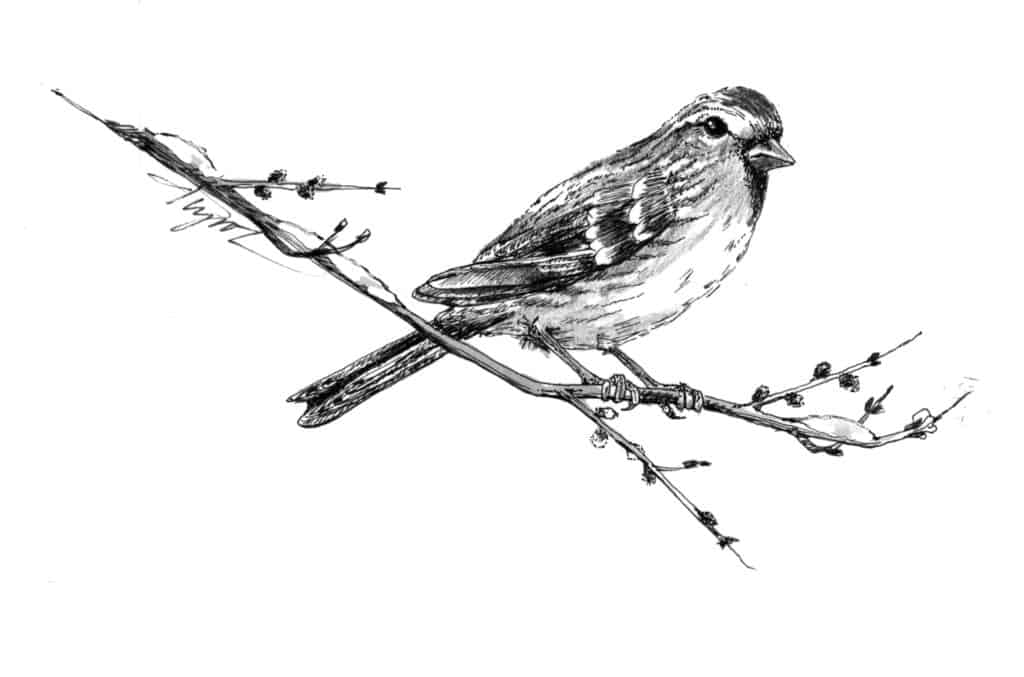
By Tyler Hoar
As winter settles in, people watching their birdfeeders hope to catch a glimpse of something out of the ordinary – perhaps a visitor from the Far North. Nothing satisfies this desire like the bubbly and charismatic common redpoll. A member of the finch family, this small songbird is similar in size to the American goldfinch. While they breed in the Arctic and northern boreal forests, common redpolls sometimes flock into the northern United States – or beyond – on a winter quest for food.
The common redpoll gets its name from the small patch of red on its forehead. The birds are light tan to brownish-gray on the back, with white on the belly and dark streaks running down their flanks. Males can be distinguished from females by a faint rose color splashed across their breasts. Both sexes feature a black, goatee-like patch on the chin. The closely related hoary redpoll looks quite similar, but with a frosted-white look to its plumage and a smaller bill that gives the appearance it has been pushed into its face.
These two redpoll species readily intermix in wintering flocks, but hoary redpolls rarely venture south of the Canadian border. They breed in high Arctic tundra and tend to overwinter farther north. If Santa had a bird feeder, they would be there.
The more abundant common redpoll is the southern breeder of the two. In North America, they range across northern Canada and Alaska, from shrubby tundra above the Arctic Circle southward to open subarctic forest. They nest in old-growth willows of the Arctic that grow just a few feet high and in small, stunted trees in the northern boreal forest. Their small nests made of twigs and lichens are lined with feathers and even caribou and musk-ox fur.
If food is plentiful in Canada’s boreal forest, redpolls will remain there all winter. Overnight temperatures average 18°F below zero, and can plummet to minus 40. Redpolls have evolved to deal with these harsh conditions. They will drop into the deep snow and make a tunnel approximately a foot long to create a roosting chamber to stay warm during the long, frigid nights. Studies on captive redpolls in Alaska found common redpolls surviving to temperatures as low as 65°F below zero and hoary redpolls to negative 88!
Redpolls are part of a group of birds affectionately known as the winter finches, which also includes pine siskins, red- and white-winged crossbills, and evening and pine grosbeaks. In years when the tree seed crops are low or have failed, these winter finches will move south out of the boreal forest into southern Canada and the northern United States looking for food. When these movements are large, like this year, it’s called an irruption.
As an irruptive species, common redpolls can show up almost anyplace when they are on the move. Last month, redpolls were recorded along the Rio Grande valley in central New Mexico, well away from their normal wintering areas. Their departure from Canada may be explained by limited availability in the southern boreal forest of yellow and white birch seeds, two preferred food items.
In addition to birches, redpolls favor the tiny seeds from alders and a wide variety of plant species found in weedy fields. While feeding, these energetic little balls of fluff can hang upside down like chickadees as they pull out seeds. Redpolls in winter also feed in weedy roadside fields, enjoying goldenrod, aster, and more than 30 other species of weeds and grasses.
They will move in an undulating flock over the fields, disappearing into the weeds to gorge on the available seeds. Redpolls have a pouch in their throat that can enlarge and allow them to collect seeds quickly and then move to a safe, warmer spot to digest their meal. When redpolls come to feeders, they prefer tube feeders filled with nyjer seed, but will also readily feed on black oil sunflower seeds.
While feeding and moving in a flock, redpolls can be heard chattering with others. Their most common call is an almost constant che che che. A drawn-out dsooeee, heard primarily from perched birds, may indicate excitement or alarm.
As the winter cold descends and we stock our feeders for the season, we can hope to be entertained by these captivating little survivalists who recognize no borders in their search for food.
Tyler Hoar is a consulting ornithologist from Oshawa, Ontario and the lead editor of “Birds of Canada,” published by Lone Pine Press. Illustration by Adelaide Tyrol Murphy. The Outside Story is assigned and edited by Northern Woodlands magazine and sponsored by the Wellborn Ecology Fund of the New Hampshire Charitable Foundation: nhcf.org.




